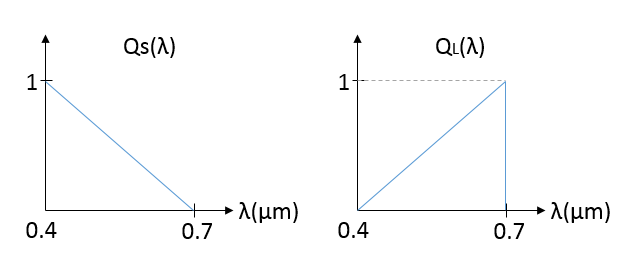| Line 13: | Line 13: | ||
a) If the color matching functions <span class="texhtml">''f''<sub>''k''</sub>(λ)</span> has negative values, it will result in negative values in <span class="texhtml">''F''<sub>''k''</sub></span>. In this case, the color can not be reproduced by this device. | a) If the color matching functions <span class="texhtml">''f''<sub>''k''</sub>(λ)</span> has negative values, it will result in negative values in <span class="texhtml">''F''<sub>''k''</sub></span>. In this case, the color can not be reproduced by this device. | ||
| − | b) The CIE color matching functions are not always positive | + | b) The CIE color matching functions are not always positive. This is the case because, to match some reference color that is too saturated, colors have to be subtracted from the <span class="texhtml">''R'',''G'',</span> and <span class="texhtml">''B''</span> primaries. This results in negative values in tristimulus values r, g, and b. So the color matching functions at the corresponding wavelength have negative values. |
c) <br> <math>\left[ {\begin{array}{*{20}{c}} | c) <br> <math>\left[ {\begin{array}{*{20}{c}} | ||
Revision as of 10:54, 13 November 2014
Contents
ECE Ph.D. Qualifying Exam in Communication Networks Signal and Image processing (CS)
Question 5, August 2013, Problem 2
- Problem 1 ,Problem 2
Solution 1:
a) If the color matching functions fk(λ) has negative values, it will result in negative values in Fk. In this case, the color can not be reproduced by this device.
b) The CIE color matching functions are not always positive. This is the case because, to match some reference color that is too saturated, colors have to be subtracted from the R,G, and B primaries. This results in negative values in tristimulus values r, g, and b. So the color matching functions at the corresponding wavelength have negative values.
c)
$ \left[ {\begin{array}{*{20}{c}} F_1\\ F_2\\ F_3 \end{array}} \right] = {\begin{array}{*{20}{c}} \int_{-\infty}^{\infty} \end{array}} \left[ {\begin{array}{*{20}{c}} f_1(\lambda)\\ f_1(\lambda)\\ f_1(\lambda) \end{array}} \right] I(\lambda)d\lambda = {\begin{array}{*{20}{c}} \int_{-\infty}^{\infty} \end{array}} M \left[ {\begin{array}{*{20}{c}} r_0(\lambda)\\ g_0(\lambda)\\ b_0(\lambda) \end{array}} \right] I(\lambda)d\lambda = M {\begin{array}{*{20}{c}} \int_{-\infty}^{\infty} \end{array}} \left[ {\begin{array}{*{20}{c}} r_0(\lambda)\\ g_0(\lambda)\\ b_0(\lambda) \end{array}} \right] I(\lambda)d\lambda = M \left[ {\begin{array}{*{20}{c}} r\\ g\\ b \end{array}} \right] $
So that, [r,g,b]t = M − 1[F1,F2,F3].
d) It exists. CIE XYZ is one example. However, XYZ has problems with its primaries, since, the primary colors are imaginary.
Solution 2:
a) f1(λ), f2(λ) and f3(λ) are the spectral functions for the three color outputs of color camera. It must be positive because we cannot produce negative spectrum.
b) No. ro(λ),go(λ)a'n'd'bo(λ) are CIE color matching. It takes negative value in order to substract some color to be saturated.
c)
$ \left[ {\begin{array}{*{20}{c}} F_1\\ F_2\\ F_3 \end{array}} \right] = {\begin{array}{*{20}{c}} \int_{-\infty}^{\infty} \end{array}} \left[ {\begin{array}{*{20}{c}} f_1(\lambda)\\ f_2(\lambda)\\ f_3(\lambda) \end{array}} \right] I(\lambda)d\lambda = {\begin{array}{*{20}{c}} \int_{-\infty}^{\infty} \end{array}} M \left[ {\begin{array}{*{20}{c}} r_0(\lambda)\\ g_0(\lambda)\\ b_0(\lambda) \end{array}} \right] I(\lambda)d\lambda = M {\begin{array}{*{20}{c}} \int_{-\infty}^{\infty} \end{array}} \left[ {\begin{array}{*{20}{c}} r_0(\lambda)\\ g_0(\lambda)\\ b_0(\lambda) \end{array}} \right] I(\lambda)d\lambda = M \left[ {\begin{array}{*{20}{c}} r\\ g\\ b \end{array}} \right] $
d)
Yes. They exist. If there is a matrix M that exist to satisfy this equation $ \left[ {\begin{array}{*{20}{c}} f_1(\lambda)\\ f_2(\lambda)\\ f_3(\lambda) \end{array}} \right] = M \left[ {\begin{array}{*{20}{c}} r_0(\lambda)\\ g_0(\lambda)\\ b_0(\lambda) \end{array}} \right] $.
The student can be more specific on the example of such case.
Related Problem
1. In a color matching experiment, the three primaries R, G, B are used to match the color of a pure spectral component at wavelength λ. Here the color matching allows for color to be subtracted from the reference color. At each wavelength λ, the matching color is given by
$ \left[ {\begin{array}{*{20}{c}} R, G, B \end{array}} \right] \left[ {\begin{array}{*{20}{c}} r(\lambda)\\ g(\lambda)\\ b(\lambda) \end{array}} \right] $
where r(λ), g(λ), and b(λ) are normalized to 1.
Further define the white point
$ W = \left[ {\begin{array}{*{20}{c}} R, G, B \end{array}} \right] \left[ {\begin{array}{*{20}{c}} r_w\\ g_w\\ b_w \end{array}} \right] $
Let I(λ) be the light reflected from a surface.
a) Calculate (re,ge,be) the tristimulus values for the spectral distribution I(λ) using primaries R,G,B and an equal energy white point.
b) Calculate (rc,gc,bc) the tristimulus values for the spectral distribution I(λ) using primaries R,G,B and white point (rw,gw,bw).
(Refer to ECE637 2004 Final Problem 4.)
2. Consider the two channel sensors with response function QS(λ) and QL(λ). Suppose that we have two primaries PL(λ) = σ(λ − 0.6) and PS(λ) = σ(λ − 0.5).
Find the color matching function $ \bar{l}(\lambda) $ and $ \bar{s}(\lambda) $ for these two primaries.
(Refer to ECE638 Lecture note 3: Trichromatic theory of color.)


